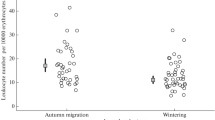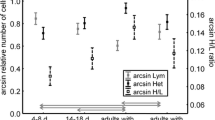Summary
Adult newts,Notophthalmus viridescens, were maintained in constant darkness and at a constant temperature of 3.5 °C or of 11.0 °C or of 21.0 °C. Animals of each group were sacrificed after an 8-day sojourn in their constant environments, at which time blood smears for each newt were prepared. Differential counts of leukocytes of the animals maintained at 3.5 °C and of those that lived at 21.0 °C were compared with the differential counts of the newts that lived at 11.0 °C. In the blood of animals maintained at 3.5 °C and at 21.0 °C, there were more neutrophils and fewer lymphocytes than the same types of cells in the blood of newts that lived at the intermediate temperature, 11.0 °C (Table 1). Those differences, statistically significant atP<0.001, may indicate that the constant high and low temperatures constitute physiological stress for this species.
Similar content being viewed by others
References
Adams AE (1930) Studies on sexual conditions inTriturus viridescens. The effects of ovarian grafts on castrated males. J Exp Zool 55:63–85
Adams AE (1938) Sexual conditions inTriturus viridescens. Artificial hermaphroditism. J Exp Zool 78:233–269
Adams AE (1940) Sexual conditions inTriturus viridescens. III. The reproductive cycle of the adult aquatic form of both sexes. Am J Anat 66:235–275
Adams AE (1946) Sexual conditions inTriturus viridescens. IV. The effects of the administration of diethylstilbestrol on adult normal and castrated males. J Exp Zool 101:1–40
Adams AE (1950) Sexual conditions inTriturus viridescens. V. The effects of the administration of diethylstilbestrol on adult normal and castrated females. J Exp Zool 113:463–498
Adams AE, Kuder A, Richards L (1932) The endocrine glands and molting inTriturus viridescens. J Exp Zool 63:1–55
Aschoff J (ed) (1981) Handbook of behavioral neurobiology. IV. Biological rhythms. Plenum Press, New York
Bennett MF (1976) Possible roles of biological rhythms in the osmoregulation of animals. In: DeCoursey PJ (ed) Biological rhythms in the marine environment. University of South Carolina Press, Columbia pp 137–144
Bennett MF, Johnson AO (1973) Osmotic stress, ACTH and the white blood cell picture in newts,Notophthalmus viridescens. J Comp Physiol 82:333–338
Bennett MF, Reap LE (1978) Photoperiod, stress and the distribution of leukocytes in the peripheral blood ofNotophthalmus viridescens. J Comp Physiol 125:205–207
Bennett MF, Gaudio CA, Johnson AO, Spisso JH (1972) Changes in the blood of newts,Notophthalmus viridescens, following the administration of hydrocortisone. J Comp Physiol 80:233–237
Maier CE, Singer M (1977) The effect of light on forelimb regeneration in the newt. J Exp Zool 202:241–244
Maier CE, Singer M (1981) The effect of prolactin on the rate of forelimb regeneration in newts exposed to photoperiod extremes. J Exp Zool 216:395–397
Morgan AH, Fales C (1940) Seasonal variations in the thyroid of adultTriturus viridescens. Anat Rec 78 (Suppl):103
Morgan AE, Johnson BJ (1942) Seasonal conditions and effects of low temperature in the thyroid glands of amphibians. II. Terrestrial phase ofTriturus viridescens. J Morphol 70:301–321
Norris DO (1980) Vertebrate endocrinology. Lea and Febiger, Philadelphia
Reinke EE, Chadwick CS (1940) The origin of the water drive inTriturus viridescens. I. Induction of the water drive in thyroidectomized and gonadectomized land phases by pituitary implantations. J Exp Zool 83:223–233
Rose P, Bennett MF (1978) Temperature and the distribution of leukocytes in newts,Notophthalmus viridescens. Am Zool 18:592
Schotté OE (1961) Systemic factors in initiation of regenerative processes in limbs of larval and adult amphibians. In: Rudnick D (ed) Synthesis of molecular and cellular structures. Ronald Press, New York, pp 161–192
Selye H (1950) The physiology and pathology of exposure to stress. Acta Inc., Montreal
Singer M (1978) On the nature of the neurotrophic phenomenon in urodele limb regeneration. Am Zool 18:829–841
Singer M, Maier CE, McNutt WS (1976) Neurotrophic acitivity of brain extracts in forelimb regeneration of the urodele,Triturus. J Exp Zool 196:131–150
Wallace H (1981) Vertebrate limb regeneration. John Wiley and Sons, Chichester New York Brisbane Toronto
Author information
Authors and Affiliations
Rights and permissions
About this article
Cite this article
Bennett, M.F., Daigle, K.R. Temperature, stress and the distribution of leukocytes in red-spotted newts,Notophthalmus viridescens . J. Comp. Physiol. 153, 81–83 (1983). https://doi.org/10.1007/BF00610345
Accepted:
Issue Date:
DOI: https://doi.org/10.1007/BF00610345




